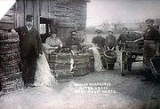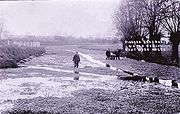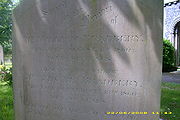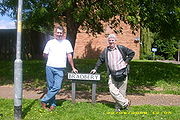
William Bradbery
Encyclopedia
William Bradbery an entrepreneur, was the first person in England to cultivate and sell watercress
on a commercial basis.
in Berkshire
(now Oxfordshire
), he was one of seven children to Thomas and Catherine Bradbery. In 1796 he married Phoebe Whiting in Marcham
, Berkshire. Until around 1805 he stayed in the Marcham area, then they moved to Springhead
, Northfleet in Kent, where he first started to cultivate watercress.
 In an article by Henry Bellenden Ker, F.R.S. in 1822, to the London Horticultural Society. He states, "I lately found that watercress is grown in this neighbourhood, by Mr. William Bradbery, for the purpose of supplying the London
In an article by Henry Bellenden Ker, F.R.S. in 1822, to the London Horticultural Society. He states, "I lately found that watercress is grown in this neighbourhood, by Mr. William Bradbery, for the purpose of supplying the London
markets. Mr. Bradbery first began to cultivate the watercress in February 1808, at Northfleet Spring Head
, near Gravesend
. For this purpose, he procured young plants, and placed them, with a small proportion of the wet earth in which they grew, in shallow running water; the plants soon formed large tufts, and rapidly spread over the water; and he then gathered the cress regularly for the London markets".
"Mr. Bradbery now having left Northfleet last year (1820),began to plant, at a considerable personal expense, beds of the cress, at West Hyde, near Rickmansworth
, Hertfordshire. Mr. Bradbery has about five acre
s of lakes planted with cress. He sends the cress in hamper
s, each containing eight dozen
bunches, to the London markets, every day throughout the year, except Sundays; three days in each week to Covent Garden
market, and the other three days to Newgate
market. This cultivation of the watercress has insured a constant and regular supply to the metropolis, and the gatherings are received much fresher, and more regularly packed, than those obtained from plants in the wild state; where little selection is made as to the quality, or attention paid to the state of the vegetable, which is usually sent up to town in sacks, and often much bruised and broken before it reaches the retail
dealer". West Hyde proved to be an ideal place to grow the cress, as water bubbled to the surface in a line of springs
West Hyde proved to be an ideal place to grow the cress, as water bubbled to the surface in a line of springs
. The water containing suitable mineral
s which assisted the growth of the cress. By the mid-19th century, William Bradbery was sending cress to many cities throughout the country, being, Manchester
, Liverpool
, York
, London, Oxford
even up to Edinburgh
. In the 1841 census return, William described himself as a "Market Gardener", employing 22 workers from West Hyde and surrounding area. He even sent cress to the Great Exhibition of 1851
, at The Crystal Palace
.
 Now residing in some style, he and his wife lived at Corner Hall, in West Hyde, the family home for over 75 years. Having created a substantial business for himself and his family, William retired in his sixties, and let his son Job take over the running of the business, who in turn passed it onto his son, Richard.
Now residing in some style, he and his wife lived at Corner Hall, in West Hyde, the family home for over 75 years. Having created a substantial business for himself and his family, William retired in his sixties, and let his son Job take over the running of the business, who in turn passed it onto his son, Richard.
William died on 11 August 1860, a little over a month before his wife Phoebe, who died on 19 September 1860. They are buried together in the churchyard of St Thomas, in West Hyde.
The watercress business continued on in the ownership of the Bradberys for some years after William died. Richard the grandson,it seems,lacked the same entrepreneurial spirit and drive of his grandfather William. So in 1927, after over a century of cress production, the watercress beds were sold off to another local grower, thus ending the Bradbery dynasty in West Hyde.
 In 1960, the Three Rivers District Council
In 1960, the Three Rivers District Council
, marked the achievements of William and his family, by naming one of the roads in nearby Maple Cross
"Bradbery". This was also done in Fulmer
, Buckinghamshire, less than four miles (6 km) away, where they named a street "Bradbery Gardens", where William's eldest son Richard, also ran a watercress farm, to complement the one in West Hyde.
Watercress
Watercresses are fast-growing, aquatic or semi-aquatic, perennial plants native from Europe to central Asia, and one of the oldest known leaf vegetables consumed by human beings...
on a commercial basis.
Early life
William was born in DidcotDidcot
Didcot is a town and civil parish in Oxfordshire about south of Oxford. Until 1974 it was in Berkshire, but was transferred to Oxfordshire in that year, and from Wallingford Rural District to the district of South Oxfordshire...
in Berkshire
Berkshire
Berkshire is a historic county in the South of England. It is also often referred to as the Royal County of Berkshire because of the presence of the royal residence of Windsor Castle in the county; this usage, which dates to the 19th century at least, was recognised by the Queen in 1957, and...
(now Oxfordshire
Oxfordshire
Oxfordshire is a county in the South East region of England, bordering on Warwickshire and Northamptonshire , Buckinghamshire , Berkshire , Wiltshire and Gloucestershire ....
), he was one of seven children to Thomas and Catherine Bradbery. In 1796 he married Phoebe Whiting in Marcham
Marcham
Marcham is a village and civil parish about west of Abingdon, Oxfordshire. It was part of Berkshire until the 1974 boundary changes transferred it to Oxfordshire.-Archaeology:...
, Berkshire. Until around 1805 he stayed in the Marcham area, then they moved to Springhead
Springhead
Springhead lies at the source of the River Ebbsfleet, just southwest of the Gravesend suburban conurbations. Springhead forms one of the major quarters of the Ebbsfleet Valley development, with housing and the associated facilities now under construction...
, Northfleet in Kent, where he first started to cultivate watercress.
Watercress cultivation

London
London is the capital city of :England and the :United Kingdom, the largest metropolitan area in the United Kingdom, and the largest urban zone in the European Union by most measures. Located on the River Thames, London has been a major settlement for two millennia, its history going back to its...
markets. Mr. Bradbery first began to cultivate the watercress in February 1808, at Northfleet Spring Head
Springhead
Springhead lies at the source of the River Ebbsfleet, just southwest of the Gravesend suburban conurbations. Springhead forms one of the major quarters of the Ebbsfleet Valley development, with housing and the associated facilities now under construction...
, near Gravesend
Gravesend, Kent
Gravesend is a town in northwest Kent, England, on the south bank of the Thames, opposite Tilbury in Essex. It is the administrative town of the Borough of Gravesham and, because of its geographical position, has always had an important role to play in the history and communications of this part of...
. For this purpose, he procured young plants, and placed them, with a small proportion of the wet earth in which they grew, in shallow running water; the plants soon formed large tufts, and rapidly spread over the water; and he then gathered the cress regularly for the London markets".
"Mr. Bradbery now having left Northfleet last year (1820),began to plant, at a considerable personal expense, beds of the cress, at West Hyde, near Rickmansworth
Rickmansworth
Rickmansworth is a town in the Three Rivers district of Hertfordshire, England, 4¼ miles west of Watford.The town has a population of around 15,000 people and lies on the Grand Union Canal and the River Colne, at the northern end of the Colne Valley regional park.Rickmansworth is a small town in...
, Hertfordshire. Mr. Bradbery has about five acre
Acre
The acre is a unit of area in a number of different systems, including the imperial and U.S. customary systems. The most commonly used acres today are the international acre and, in the United States, the survey acre. The most common use of the acre is to measure tracts of land.The acre is related...
s of lakes planted with cress. He sends the cress in hamper
Hamper
A hamper is a primarily British term for a wicker basket, usually large, that is used for the transport of items, often food.In North America, the term generally refers to a household receptacle for clean or dirty clothing, regardless of its composition, i.e...
s, each containing eight dozen
Dozen
A dozen is a grouping of approximately twelve. The dozen may be one of the earliest primitive groupings, perhaps because there are approximately a dozen cycles of the moon or months in a cycle of the sun or year...
bunches, to the London markets, every day throughout the year, except Sundays; three days in each week to Covent Garden
Covent Garden
Covent Garden is a district in London on the eastern fringes of the West End, between St. Martin's Lane and Drury Lane. It is associated with the former fruit and vegetable market in the central square, now a popular shopping and tourist site, and the Royal Opera House, which is also known as...
market, and the other three days to Newgate
Newgate
Newgate at the west end of Newgate Street was one of the historic seven gates of London Wall round the City of London and one of the six which date back to Roman times. From it a Roman road led west to Silchester...
market. This cultivation of the watercress has insured a constant and regular supply to the metropolis, and the gatherings are received much fresher, and more regularly packed, than those obtained from plants in the wild state; where little selection is made as to the quality, or attention paid to the state of the vegetable, which is usually sent up to town in sacks, and often much bruised and broken before it reaches the retail
Retailing
Retail consists of the sale of physical goods or merchandise from a fixed location, such as a department store, boutique or kiosk, or by mail, in small or individual lots for direct consumption by the purchaser. Retailing may include subordinated services, such as delivery. Purchasers may be...
dealer".

Spring (hydrosphere)
A spring—also known as a rising or resurgence—is a component of the hydrosphere. Specifically, it is any natural situation where water flows to the surface of the earth from underground...
. The water containing suitable mineral
Mineral
A mineral is a naturally occurring solid chemical substance formed through biogeochemical processes, having characteristic chemical composition, highly ordered atomic structure, and specific physical properties. By comparison, a rock is an aggregate of minerals and/or mineraloids and does not...
s which assisted the growth of the cress. By the mid-19th century, William Bradbery was sending cress to many cities throughout the country, being, Manchester
Manchester
Manchester is a city and metropolitan borough in Greater Manchester, England. According to the Office for National Statistics, the 2010 mid-year population estimate for Manchester was 498,800. Manchester lies within one of the UK's largest metropolitan areas, the metropolitan county of Greater...
, Liverpool
Liverpool
Liverpool is a city and metropolitan borough of Merseyside, England, along the eastern side of the Mersey Estuary. It was founded as a borough in 1207 and was granted city status in 1880...
, York
York
York is a walled city, situated at the confluence of the Rivers Ouse and Foss in North Yorkshire, England. The city has a rich heritage and has provided the backdrop to major political events throughout much of its two millennia of existence...
, London, Oxford
Oxford
The city of Oxford is the county town of Oxfordshire, England. The city, made prominent by its medieval university, has a population of just under 165,000, with 153,900 living within the district boundary. It lies about 50 miles north-west of London. The rivers Cherwell and Thames run through...
even up to Edinburgh
Edinburgh
Edinburgh is the capital city of Scotland, the second largest city in Scotland, and the eighth most populous in the United Kingdom. The City of Edinburgh Council governs one of Scotland's 32 local government council areas. The council area includes urban Edinburgh and a rural area...
. In the 1841 census return, William described himself as a "Market Gardener", employing 22 workers from West Hyde and surrounding area. He even sent cress to the Great Exhibition of 1851
The Great Exhibition
The Great Exhibition of the Works of Industry of all Nations or The Great Exhibition, sometimes referred to as the Crystal Palace Exhibition in reference to the temporary structure in which it was held, was an international exhibition that took place in Hyde Park, London, from 1 May to 15 October...
, at The Crystal Palace
The Crystal Palace
The Crystal Palace was a cast-iron and glass building originally erected in Hyde Park, London, England, to house the Great Exhibition of 1851. More than 14,000 exhibitors from around the world gathered in the Palace's of exhibition space to display examples of the latest technology developed in...
.
Retirement

William died on 11 August 1860, a little over a month before his wife Phoebe, who died on 19 September 1860. They are buried together in the churchyard of St Thomas, in West Hyde.
The watercress business continued on in the ownership of the Bradberys for some years after William died. Richard the grandson,it seems,lacked the same entrepreneurial spirit and drive of his grandfather William. So in 1927, after over a century of cress production, the watercress beds were sold off to another local grower, thus ending the Bradbery dynasty in West Hyde.
Recognition

Three Rivers District Council
Three Rivers District Council is the local authority for the Three Rivers non-metropolitan district of England, the United Kingdom. Three Rivers is located in the south-west of Hertfordshire, in the East of England region...
, marked the achievements of William and his family, by naming one of the roads in nearby Maple Cross
Maple Cross
Maple Cross is a village in Hertfordshire, England with a large proportion of the housing being either council owned or previously council owned. The area is served by junction 17 of the M25 motorway, which makes up one of the boundaries of the village...
"Bradbery". This was also done in Fulmer
Fulmer
Fulmer is a village and civil parish in South Buckinghamshire district in Buckinghamshire, England. The village is now contiguous with Gerrards Cross but remains administratively separate....
, Buckinghamshire, less than four miles (6 km) away, where they named a street "Bradbery Gardens", where William's eldest son Richard, also ran a watercress farm, to complement the one in West Hyde.
External links
- watercress.co.uk - Watercress historical facts

